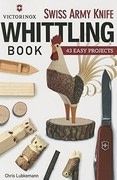
Sharpening And Honing Tools
Extract from Victorinox Swiss Army Knife Book of Whittling • By Chris Lubkemann • Published by Fox Chapel PublishingAbout
Victorinox Swiss Army Knife Book of Whittling
The first and most important rule of carving is that your knife must be sharp. The Victorinox Swiss Army Knives are among the few pocketknives that I’ve found to be sharp enough right out of the box to do decent carving. However, as with any good- quality knife, you will need to know how to sharpen and hone the blades in order to do the most precise and detailed carving.
There are all kinds of methods and devices for sharpening knives. I will share with you my own very simple sharpening system, but feel free to experiment and find what works best for you. Like any method or system, mine takes a little practice, but it does work, and I’ve been satisfied with it for quite a few years. The price is pretty good, too—practically nothing, after a very small initial investment.
If I’m starting out with a totally dull knife, or even a new one that’s not sharp, I use a two-sided sharpening stone to start the process (see Step 1). Then, follow Steps 2–4 to hone, polish, and strop the blade so it’s ready to carve. If I’m starting with a blade that only needs a touch of sharpening, I’ll start with the finest grit of wet-or-dry sandpaper (Step 3) and finish with a few strops on the leather. Either way, be sure to wash your hands after sharpening and honing your knife. The gray residue on your hands will end up smudging your carving project.
-
 Sarah Sylvia S. favorited Sharpening And Honing Tools
18 Jul 06:24
Sarah Sylvia S. favorited Sharpening And Honing Tools
18 Jul 06:24
-
 shelly.anderson.547 added Sharpening And Honing Tools to Whittling and such
03 Oct 14:37
shelly.anderson.547 added Sharpening And Honing Tools to Whittling and such
03 Oct 14:37
-
 Mary C. favorited Sharpening And Honing Tools
18 Sep 13:25
Mary C. favorited Sharpening And Honing Tools
18 Sep 13:25
-
 Fox Chapel Publishing published her project Sharpening And Honing Tools
18 Sep 06:00
Fox Chapel Publishing published her project Sharpening And Honing Tools
18 Sep 06:00
You Will Need
-
 Step 5
Step 5Finally, strop (wipe) the blade on a piece of leather. The rough backside of an old leather belt works fine. Apply a little bit of stropping compound to the strop. With the blade flat against the strop, stroke it away from the edge a few times on each side. Wipe the blade clean, and you’re ready
to carve.








